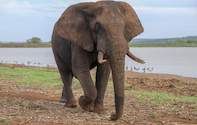
Stabilizing Populations
The elephant population growth has decreased from 6.5% per annum in 1994 to 3.5% annually in 2003. Kruger National Park large mammal ecologist, Sam Ferreira, said that the elephant population in the Kruger is manageable and stabilizing. He explained that although the population size was increasing, a balance was created by the decreasing birth rates.Ferreira said that the 2012 elephant consensus recorded an amount of 16 700 elephants in the Kruger. In 2013, he addressed concerns that the elephant population was negatively impacting the environment in the Kruger saying that the issue had not yet reached crisis levels.
Dr Salomon Joubert, the former director of the park, was quoted as saying there was an overabundance of elephant in the park and that it was a huge problem. "It is going to be extremely difficult or impossible to reduce the population manageable to levels," he said.
Opposing Joubert's proposal to cull thousands of elephants, Ferreira said that the effects of the elephants need to be addressed and controlled, rather than the elephants themselves.
How Do We Manage?
The Game Rangers' Association of Africa (GRAA) has taken an official standpoint on the issue of elephant management, saying that "overpopulations of elephants (particularly in fenced-in protected areas) may pose significant threats to biodiversity" and that elephants pose management problems that cannot usually be solved by means appropriate to other species.
They say that all options for managing elephants are limited with "inherent logistical and ethical constraints". Translocation is deemed to be the most ethically acceptable option, but opportunities are limited and the traumas suffered by elephant populations that undergo translocation are similar to those of culling. Through this method, however, the population is not reduced at all but merely dispersed, spreading the environmental impact to a larger area.
After 2006, the decision was made to close some of the park's waterholes in an effort to force the herds to natural bodies of water, allowing the areas around the man-made waterholes to recover from the large numbers of animals.
Contraception was viewed as ethically acceptable, but has limitations socially, cost wise and requires long time periods to actually decrease elephant numbers "which some management authorities cannot currently afford". Also, vasectomies cannot be performed on adult males as the procedure places health risks on the animal, and the process cannot be reversed.
Increasing the amount of land available for elephants and linking up current conservation areas was considered to be "clearly desirable" but could not "offer solutions for current overpopulation problems". The GRAA pointed out that elephants and humans favour the same types of land, making prime land hard to acquire for elephant conservation.
The organisation also said that diversion of funds for new land would likely be detrimental to the management of existing protected areas. Humanely conducted culling and hunting "is considered by the GRAA to be an ethical and valid option for elephant management" when weighted up against biodiversity loss and human-elephant conflicts.
References
News24https://www.news24.com/Green/News/Kruger-elephants-manageable-SANParks-20130503
eNCA
https://www.enca.com/south-africa/african-elephants-between-rock-and-hard-place
Learn more about Elephant Population Management in Kruger Park

